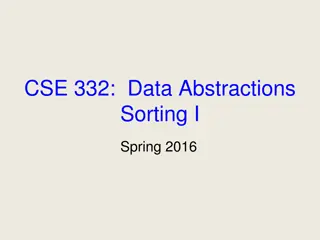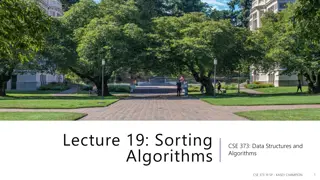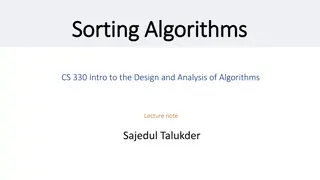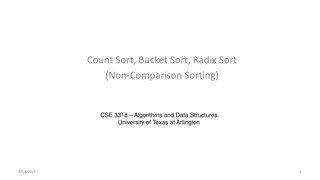
Sorting Algorithms: Importance and Types
Discover the significance of sorting algorithms for efficient data organization and faster data retrieval. Explore simple and complex sorting methods along with the benefits of distribution sorts in this comprehensive guide.
Download Presentation

Please find below an Image/Link to download the presentation.
The content on the website is provided AS IS for your information and personal use only. It may not be sold, licensed, or shared on other websites without obtaining consent from the author. If you encounter any issues during the download, it is possible that the publisher has removed the file from their server.
You are allowed to download the files provided on this website for personal or commercial use, subject to the condition that they are used lawfully. All files are the property of their respective owners.
The content on the website is provided AS IS for your information and personal use only. It may not be sold, licensed, or shared on other websites without obtaining consent from the author.
E N D
Presentation Transcript
OVERVIEW 1) Why do we need sorting algorithms? 2) Simple sorting algorithms 3) More complicated sorting algorithms 4) Distribution sorts
1) WHY DO WE NEED SORTING ALGORITHMS? Sorting can help avoid repeating data any repeating data will be placed together within a sorted array and can thus be easily removed if necessary Searching through data is made faster: without sorting, every value must be checked, however, sorted arrays allow for faster searches such as binary searching, which does not look at every value Sets of data can be easily compared when both sets are ordered it is easy to see where the sets of data have the same and different values.
1) WHY DO WE NEED SORTING ALGORITHMS? - Sets of data can be easily compared when both sets are sorted For example: 3, 1, 10, 9, 6, 5, 8 5, 6, 10, 8, 2, 9, 1 It is hard to find the differences between the two lists as compared to 1, 3, 5, 6, 8, 9, 10 1, 2, 5, 6, 8, 9, 10 It is easy to tell the difference between the two lists, namely a 3 changing to a 2
2) SIMPLE SORTING ALGORITHMS SELECTION SORT Selection Sort works by finding the smallest value in an array, and then placing that value at the start of the array. It then repeats with the second smallest value, and so on, until you have a sorted array The sort is easy to code, however, due to its O(n ) time complexity, it should not be used to sort large arrays, nor should it be used when the speed of the algorithm is important
SELECTION SORT PSEUDOCODE length < The size of the array For i = 0 to length - 1 { min_Index < i For j = i + 1 to length { } Swap the values at i and min_Index in the array } if array[ i ] < array[ min_Index ] min_Index < j
2) SIMPLE SORTING ALGORITHMS BUBBLE SORT Bubble Sort works by comparing every adjacent pair of numbers and swapping them if the larger number is positioned first. This is repeated n times (where n is the number of elements in the array) Once again, this sort is easy to code and has a time complexity of O(n ). Because more swaps take place than the selection sort, this sort is less efficient and should not be used to sort large arrays This sort can be fast when used on a nearly sorted array, assuming it has been coded to have a flag (the sort stops when no more changes are being made)
BUBBLE SORT PSEUDOCODE length < The size of the array For i = 0 to length - 1 { For j = 0 to length - i - 1 { if array[ j ] > array[ j + 1 ] } } Swap the values at j and j + 1 in the array
3) MORE COMPLICATED SORTING ALGORITHMS MERGE SORT Merge Sort works by breaking an array into sub-arrays, each containing an individual element. Every 2 sub-arrays are merged to make a larger, ordered sub-array. Those sub-arrays are once again merged, and this continues until there is only one array, the final sorted array. This sort is much more complicated to code, and has a time complexity of O(n log n), making it much better to use for large amounts of data.
MERGE SORT VISUALIZATION 8 23 47 91 8 23 47 91 23 91 47 8 91 47 8 23 23 91 8 47
3) MORE COMPLICATED SORTING ALGORITHMS QUICK SORT Quick Sort works by choosing a pivot and then separating every value greater than the pivot from every value smaller than the pivot, making two smaller sub-arrays. At this point, the pivot is in its final location. Quicksort is then recursively called on these sub-arrays, until every element is in the correct order Quicksort is often considered the most efficient sorting algorithm. It is part of the hybrid sort used in the C++ sort() function (Introsort) and is also used in the java Arrays.sort() function. The time complexity is on average O(n log n); however, the worst case is O(n ) (although this case is unlikely when pivots are chosen at random)
QUICK SORT VISUALIZATION Red numbers are in their final position The numbers that are lower are the current pivots 45 81 15 12 32 15 is randomly chosen as the pivot The left sub-array has 1 element (12), so it is sorted 45 81 12 32 15 81 is randomly chosen as the pivot 12 32 15 45 81 32 is randomly chosen as the pivot The right sub-array has 1 element (45), so it is sorted 45 15 12 81 32 The entire array has now been sorted 45 12 81 32 15
4) DISTRIBUTION SORTS COUNTING SORT Distribution sorts work by moving data from the input into multiple structures, and then collecting them at the output, instead of comparing the values themselves. Counting Sort works by counting the number of times every number is found inside an array, and then displaying each number based on the number of times it was counted This sort can be extremely efficient but becomes less efficient the greater the size of the set of possible numbers is. The sort also only works when every number falls within a particular set of possibilities The time complexity is O(n + k), where k is the range of the possible values
COUNTING SORT VISUALIZATION Unsorted Array: 7, 6, 4, 8, 5, 1, 6, 5, 5, 2, 5, 9, 6, 0, 9 Array of possibilities: 1 5 0 3 9 2 4 7 8 6 1 1 1 0 1 4 3 1 1 2 Counter for each possibility: Sorted Array: 0, 1, 2, 4, 5, 5, 5, 5, 6, 6, 6, 7, 8, 9, 9
4) DISTRIBUTION SORTS RADIX SORT Radix Sort works by splitting the numbers into buckets based on an individual digit. For example, using a base 10 radix sort, there will be 10 buckets for the digits 0 9. First, the numbers are grouped based on their least significant digit (LSD) and then combined back into an array one bucket at a time. Then they are sorted by the second least significant digit, then the third, until the most significant digit (MSD). This sort is more complicated to code than the earlier mentioned simpler algorithms and has a time complexity of O(n * k), where k is the number of digits in the largest number.
RADIX SORT EXAMPLE Example using 5 Base 3 numbers - 112, 2, 120, 201, 20 (2 is viewed as 002) 0 Bucket: 120, 020 1 Bucket: 201 2 Bucket: 112, 002 Looking at the last digit New Array: 120, 20, 201, 112, 2 0 Bucket: 201, 002 1 Bucket: 112 2 Bucket: 120, 020 Looking at the second digit New Array : 201, 2, 112, 120, 20 0 Bucket: 002, 020 1 Bucket: 112, 120 2 Bucket: 201 Looking at the first digit Final Sorted Array : 2, 20, 112, 120, 201
EXTRA INFORMATION The two parameters are the start and end points of the array that you want to be sorted Using the C++ built-in Sort method: int array[] = { 12, 0, 5, -31, 95, 91, -65, 1 }; size_t size = sizeof(array) / sizeof(array[0]); sort(array, array + size); All animation credited to https://visualgo.net/bn/sorting






















